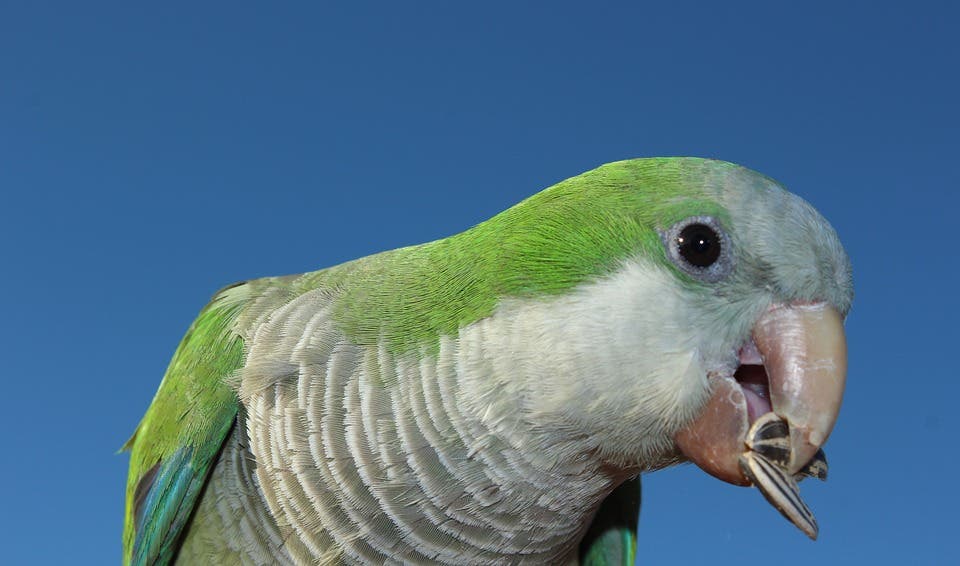A new study reports that around 56 different parrot species have been spotted in the wild in 43 states across the USA. These birds aren’t native to the continent — but 25 species are now breeding in 23 different states, effectively becoming naturalized to the country.

Image via Pixabay.
In the 1950s and 60s, tens of thousands of monk parakeets were imported to the USA as pets from South America. Over the years, many escaped (or worse, were released) from their owners. By 1968, they were breeding in the wild across 10 states, including a colony in the Hyde Park neighborhood of Chicago, home of the University of Chicago campus. Stephen Pruett-Jones, now a Ph.D. and ecologist at the University of Chicago, first stumbled upon these birds back in 1988, when he first came to Chicago, in Hyde Park.
Made in the USA
“I have never actually held a wild parrot in the United States,” he says. “But indirectly I’ve become the spokesperson for parrot research here because when I saw the monk parakeets in Chicago, I realized nobody else was working on them.”
The US originally harbored two native species of parrot: the Carolina parakeet and the thick-billed parrot. The Carolina parakeet is now extinct, while the thick-billed parrot, a Mexican species that ranged into the southwestern states, was driven out of the U.S. Needless to say, this made for a very peculiar sighting when, on his daily commute, Pruett-Jones spotted a large group of parakeets. Although his usual area of research focuses on Australian wild birds such as wrens, he started sending out students to study the birds and eventually organized an annual lab project to count them. Over time, this project grew much larger than he had anticipated.
Pruett-Jones recently published a study, alongside Jennifer Uehling, a former UChicago undergraduate student now working on a Ph.D. at Cornell University, and Jason Tallant of the University of Michigan, detailing the findings. Between 2002 and 2016, the paper reports, 56 different parrot species were spotted in the wild in 43 states. Of these, 25 species are now breeding in the wild in 23 different states.
“Many of them were escaped pets, or their owners released them because they couldn’t train them or they made too much noise — all the reasons people let pets go,” Pruett-Jones said. “But many of these species are perfectly happy living here and they’ve established populations. Wild parrots are here to stay.”
The study drew on two databases of bird sightings, which were used to track the new ranges of these naturalized parrot species. The first (the Christmas Bird Count) is an annual survey organized by the National Audubon Society that gathers data on US birds during a two-week period (December 14 to January 15) each year. The second one (eBird) is an online database where amateur and professional bird watchers can log all the birds they have seen.
The team reports that the most common species of parrots in the USA today are monk parakeets, the Red-crowned Amazon, and the Nanday Parakeet. They mostly gravitate in the warmer regions of Florida, Texas, and California, but large populations of parrots also roost around cities like New York and Chicago. And, in a somewhat ironic twist, there are now more Red-crowned Amazons living in California than there are in their original habitats in Mexico.
“The entire conservation focus for this species is now on a non-native, introduced, naturalized population,” Pruett-Jones added. “The survival of the species is most likely going to come from efforts to save it someplace where it never existed before.”
Monk parakeets are considered to be agricultural pests in South America, the team writes, but this doesn’t seem to be the case in the US as well. Apart from a few isolated cases, the feral US parrots also don’t seem to be competing with native birds. The Chicago parakeets seem to live in and off the city around the year — they don’t migrate at all, and mostly dine in the city’s parks and open grassy areas. One of Pruett-Jones’ students discovered that make it through the harsh local winters by switching almost exclusively to backyard bird feeders from December to February.
Monk parakeets are a bit of trouble, however, as they build rather bulky nests (they’re the only species of parrot that builds their own nest) which can damage utility lines. The birds aren’t as numerous as they used to be, dwindling from around a peak of 400 to around 30 today. This trend seems consistent across all the birds in the study, the team notes, perhaps due to a disease or parasite — and this may actually be threatening the species’ survival.
“Because of human activity transporting these birds for our own pleasure, we have inadvertently created populations elsewhere,” says Pruett-Jones’. “Now for some of these parrots, they may become critical to the survival of the species.”
The paper “Status of naturalized parrots in the United States” has been published in the Journal of Ornithology.






